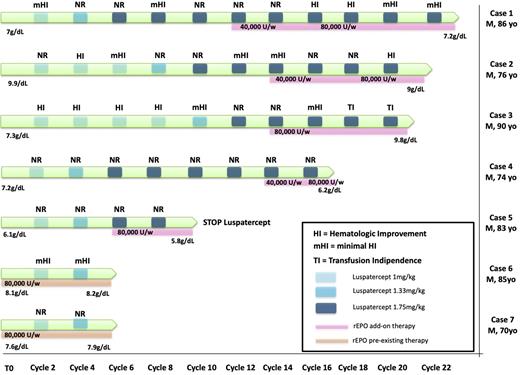Abstract
Myelodysplastic syndrome with ring sideroblasts (MDS RS) and SF3B1 mutation is generally marked by severe anemia, limited response to recombinant erythropoietin (rEPO) and consequent transfusion burden. Recently, luspatercept, a TGF-beta-pathway inhibitor, was shown beneficial in approximately 1/3 of patients by reactivating late-stage erythropoiesis. Since rEPO mainly acts on early-stage erythropoiesis, we hypothesized a possible role of combination therapy in this subset of patients.
Seven patients with MDS RS treated with luspatercept in combination with rEPO at two tertiary hematologic centers in Milan, Italy were retrospectively evaluated. Luspatercept was administered according to current data sheet (1 to 1.75mg/kg every 3 weeks). Endogenous (e)EPO was evaluated before rEPO start, and patients with values < 200 IU/L received subcutaneous epoetin alpha 40,000 U/week, while those with higher values received 80,000 U/week. Hematologic data and number of RBC transfusions were collected at each cycle of luspatercept, and hematologic improvement (HI) was assessed according to the revised International Working Group (IWG) 2018.
All 7 patients were males, with a median age of 83 years old (70-90). According to IPSS-R, three patients were classified as intermediate risk, while the others were lower risk. At the time of luspatercept start all patients were anemic with median Hb values of 7.3 g/dL (6.1-9.9), while median neutrophil (3.1x103/mm3, 0.8-4.9) and platelet (200x103/mm3,43-282) counts were normal. The median number of RBC units transfused in the last 8 weeks before luspatercept was 8 (3-11). Figure 1 details the timing and doses of luspatercept and rEPO treatment. In total, 5 patients received rEPO as add-on treatment due to non- or loss of response to luspatercept. Median eEPO values in these subjects were 250 (99-445) IU/L. Overall, three patients (Case 1, 2 and 3) achieved HI, and one of them became transfusion independent. Specifically, Case 1 achieved minimal HI with luspatercept after cycles 2 and 6, and lost response; rEPO was added at cycle 12 with HI after cycle 14. Case 2 initially reached HI after cycle 4 but showed several oscillations of pre-transfusion Hb (7 to 9 g/dL). At cycle 13 rEPO was added obtaining HI after cycle 20. Case 3 achieved HI after 2 cycles of luspatercept but lost response after cycle 10; rEPO was added at cycle 14 and he became transfusion independent. Patient 6 had rEPO as a pre-existing therapy and experienced a minimal HI after luspatercept start; rEPO had not been stopped to avoid a drop of pre-transfusion Hb. The other patients did not respond to luspatercept, nor to combination with rEPO, which was added at cycles 14 and 7 (Case 4 and Case 5), or already ongoing at luspatercept start in Case 7. Notably, no treatment emerging adverse events were registered with the combination.
In conclusion, despite the small number of cases, these data show for the first time that combination therapy of luspatercept plus rEPO is feasible and beneficial in about one third of subjects. Concomitant stimulation of early and late-stage erythropoiesis may be an interesting strategy that requires further investigation.
Disclosures
Barcellini:Apellis: Honoraria; Alexion: Honoraria; Janssen: Honoraria; Biocryst: Honoraria; Incyte: Membership on an entity's Board of Directors or advisory committees; Momenta: Honoraria; Novartis: Honoraria; SOBI: Honoraria; Bioverativ: Membership on an entity's Board of Directors or advisory committees; Agios: Honoraria, Research Funding; Sanofi: Honoraria, Speakers Bureau. Fattizzo:Novartis: Speakers Bureau; Sobi: Speakers Bureau; Alexion: Speakers Bureau.
Author notes
Asterisk with author names denotes non-ASH members.


This feature is available to Subscribers Only
Sign In or Create an Account Close Modal